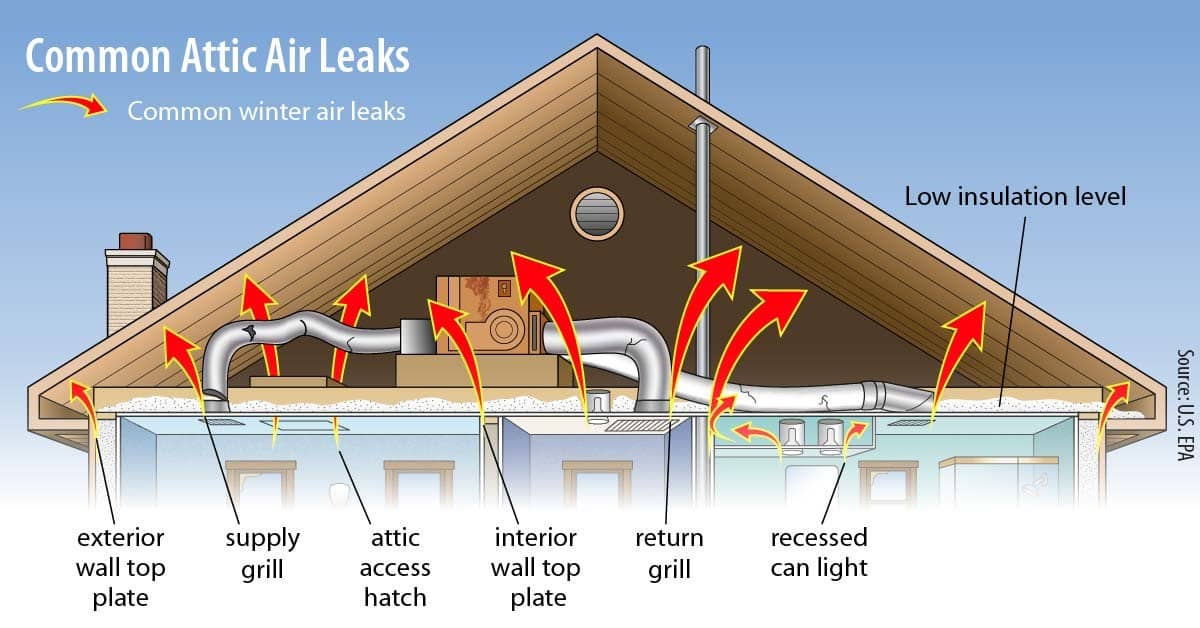Considering HVAC System Installation?
With the heat of SoCal, it is easy to want air conditioning for your home, but doing it the best way to conserve energy might be the best plan for installation. A utility bill can get pretty high with normal use of Air Conditioning, so considering all the possible upgrades to make sure your HVAC is efficient is a wise decision. Most of the common causes of poor HVAC efficiency are air leaks or poor insulation. These problems can easily be resolved with proper tools and equipment, or you could consider hiring an attic professional to do an Attic Inspection and provide a quote for services to cover all these issues.
Before the HVAC System Installation, Upgrade your Insulation!
When looking at the process of installing an HVAC system, there are lots of areas that should be covered with insulation before installation of the HVAC ventilation and air handler systems. We highly recommend that if you are getting an HVAC to first install insulation.
Benefits of Upgrading HVAC System and Insulation
The comfort of your home is an obvious benefit to these upgrades, but what else can be improved? When you get the air moving in your home you can see a noticeable change in the odor of the home, but on top of that, it may be more consistent. Also, with a professional working to do this install, there is a high chance they also air sealed your attic or created rodent barriers, this will help to keep pests out!

This image was provided by the EPA to help homeowners learn about the financial, as well as comfort and environmental, benefits of sealing and insulating their attics and encourage homeowners to take action to improve the insulation in their own attics.
Importance of Professional HVAC System Installation
If the HVAC system has been installed well, you can also count that the risk of mold or moisture build up in the attic are less likely. Professionals installing HVAC will be prepared to add in attic fans and cooling systems to keep the attic free from moisture build up leading to mold. An additional benefit to properly assessing your HVAC system and installing insulation is that you can lower the inefficiencies for temperature control. A professional install can do a lot for your home including adding more comfort, less risks of mold or pests, and could add up to savings in utility bills!
What to Expect from an HVAC System Installation Process
When it comes to HVAC system installation, understanding the process is essential to ensure a seamless and efficient operation. This is not intended to be step-by-step HVAC system installation process, but to help homeowners know what to expect from planning and preparation to system testing and commissioning of the project. Whether you are considering a new installation or upgrading your existing system, this process is about the same after removal of the old HVAC system.
- Initial Assessment and Planning: The HVAC installation process begins with an initial assessment of your home’s heating and cooling needs. You should have a licensed HVAC professional conduct a thorough evaluation, taking into account factors such as the size of your home, insulation levels, existing ductwork, and local climate conditions. Based on this assessment, the technician will recommend the most suitable HVAC system type and capacity to meet your specific requirements. Before you install, make sure to revisit the paragraph above about considering the importance of installing insulation prior to an HVAC system installation!
- Insulation and Sealing: To enhance the energy efficiency of your HVAC system, proper insulation and sealing are crucial. The HVAC technician will inspect and upgrade the insulation in key areas, such as the attic, walls, and crawl spaces. Air leaks and gaps around windows and doors will be sealed to prevent energy loss and ensure optimal indoor comfort.
- Ductwork and Airflow Analysis: Proper ductwork design is crucial for ensuring efficient airflow and even distribution of conditioned air throughout your home. During this phase, the HVAC technician will evaluate the existing ductwork (if applicable) and determine if any modifications or repairs are necessary. If your home doesn’t have ductwork, the technician will plan for the installation of new ducts or suggest alternative options.
- Equipment Selection and Sizing: Once the assessment and airflow analysis are complete, the next step is to select the HVAC equipment. This includes choosing an energy-efficient furnace or air handler, air conditioner, heat pump, or hybrid system that aligns with your home’s heating and cooling needs. Proper equipment sizing is essential to ensure optimal performance, energy efficiency, and longevity of the system.
- Installation and Configuration: The actual HVAC system installation process begins with positioning and mounting the HVAC equipment. For a traditional HVAC system installation, the furnace or air handler is installed indoors, typically in the basement, attic or utility room, while the air conditioner or heat pump is placed outside. Ductwork (if required) is carefully installed and connected to the HVAC equipment. The refrigerant lines and electrical connections are also set up during this phase. Additionally, if you are opting for a smart thermostat or attic cooling fan, they will be installed and configured to ensure seamless integration with your new HVAC system.
- System Testing and Commissioning: After the installation and insulation are complete, the HVAC system undergoes comprehensive testing and commissioning. The technician will check for proper airflow, refrigerant levels, and electrical connections. The system will be tested for heating and cooling efficiency, and any adjustments will be made to achieve optimal performance.
Tax Credit for Improving My HVAC System?
Did you know that in 2023 you can get up to $1200 in tax credit for properly insulating your home? According to the Energy Star website regarding federal tax credits, the overall total limit for an efficiency tax credit in one year stands at $3,200.

This limit can be broken down into specific categories as follows:
- Home Envelope Improvements (windows/doors/skylights, insulation, electrical) and Furnaces, Boilers, and Central Air Conditioners have a combined total limit of $1,200.
- Heat Pumps, Heat Pump Water Heaters, and Biomass Stoves/Boilers fall under a separate category with an annual total limit of $2,000.
It’s essential to note that ENERGY STAR certified geothermal heat pumps are eligible for a separate tax credit and are not counted against the aforementioned limits.
What Products are Eligible for Tax Credit?
According to the Energy Star website regarding federal tax credits, the following products are eligible:
- Typical bulk insulation products, including batts, rolls, blow-in fibers, rigid boards, expanding spray, and pour-in-place, can qualify for the tax credit.
- Air sealing products that help reduce air leaks are also eligible, provided they come with a Manufacturer’s Certification Statement.
These products include:
- Weather striping*
- Spray foam* in a can, designed for air sealing purposes
- Caulk* designed for air sealing purposes
- House wrap*
*Please ensure that the products meet the specified criteria to qualify for the tax credit.
Old HVAC System Needs to be Replaced?
Considering the Energy Star website’s information on federal tax credits, it is recommended that if you have an old heating or cooling system and are contemplating installing a new air source heat pump, it is wise to prioritize optimizing your attic insulation. By doing so, you can avoid paying for more heating and cooling than necessary. Combining these upgrades in the same year would enable you to claim a tax credit of up to $1,200 for the insulation and up to $2,000 for the heat pump.
Likewise, you have the option to combine a heat pump installation with window/door replacements, making it another eligible opportunity for tax credits. Be sure to check out the Energy Star website to learn more about these tax credits, if you need help, call us!
Energy-Efficient HVAC Systems
For homeowners seeking guidance on HVAC energy efficiency, the Energy Star website offers a valuable resource. While downloading and reading the manual can be beneficial, we highly recommend consulting a professional for personalized assistance in selecting the best system for your home. Every home has unique heating and air conditioning requirements, and a thorough on-site assessment by a professional is essential. In some cases, the expert may find that improving insulation alone can significantly enhance your home’s comfort. However, for larger or older homes, additional measures, such as upgrading the HVAC system, might be necessary. The insights provided by a professional will encompass both insulation improvements and the HVAC system installation.
Attic Health Wrap-Up
When considering HVAC system installation for your home, prioritizing energy efficiency and proper insulation is the key to long-term comfort and cost savings. The scorching heat of Southern California may tempt you to rush into air conditioning, but taking the time to assess your home’s specific needs and investing in energy-efficient HVAC systems can lead to significant benefits. Hiring a professional to conduct a thorough on-site assessment, recommend suitable insulation upgrades, and install the right HVAC system is essential for optimal performance and comfort. Additionally, don’t forget to explore available tax credits and incentives for insulation and HVAC system improvements, as they can further offset costs and contribute to a more sustainable future. By making informed choices and embracing energy-efficient practices, you can create a comfortable and eco-friendly living space while enjoying reduced utility bills and a positive impact on the environment. Remember, your home is more than just a place to live; it’s a sanctuary of comfort and energy-conscious living.

